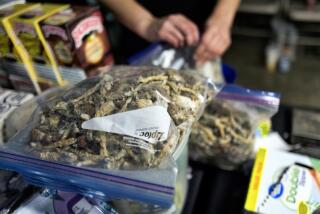Alternative Treatments: The Benefits--and the Risks
- Share via
ACUPUNCTURE
DEFINITION: Ancient Chinese technique using fine needles that pierce the skin, supposedly tapping into the invisible grid of flowing energy called qi that controls organs.
BENEFITS CLAIMED: For pain relief, controlling addictions, asthma, allergies, depression, anxiety, high blood pressure and digestive disorders.
EVIDENCE: A 1997 federally organized scientific panel says only that it can ease post-operative pain and nausea from anesthesia, cancer chemotherapy and pregnancy. Other uses uncertain or unproven. May work by triggering release of body’s own painkilling chemicals.
MEDICAL RISKS: Since 1965, just 10 documented incidents of internal organs damaged by needle sticks. But beware poorly sterilized needles (disposable are best) and ill-trained practitioners.
*
AROMATHERAPY
DEFINITION: Essential plant oils and essences used to treat physical and psychological problems.
BENEFITS CLAIMED: Said effective against stress, asthma, colds, premenstrual syndrome, difficult labor, immune deficiencies and cystitis, among other things.
EVIDENCE: Virtually no controlled clinical studies back up the many medical claims, though smells are known to trigger sensations and arouse emotions.
MEDICAL RISKS: Few harmful effects imaginable. No professional licensing and school accreditation in U.S. for aromatherapists.
*
AYURVEDA
DEFINITION: 3,000-year-old Indian medical practice holds that illness signifies lack of physical, emotional and spiritual harmony. Uses diet, exercise, yoga, meditation, herbs and massage.
BENEFITS CLAIMED: Digestive disorders, heart disease, arthritis, allergies, wound healing, anxiety and viral hepatitis are listed as benefits.
EVIDENCE: Exercise and relaxation not controversial, and some ayurvedic herbs may be effective, but beware nontoxic treatments for cancer and other serious diseases.
MEDICAL RISKS: Some medications contain toxic metals such as lead and mercury. Harsh traditional practices such as blood-letting, bowel purging and induced vomiting may make matters worse.
*
CHELATON
DEFINITION: A standard drug treatment for heavy-metal poisoning, it is highly controversial when promoted as cardiovascular disease treatment.
BENEFITS CLAIMED: Said to supplant bypass surgery or balloon angioplasty, supposedly by leeching artery-clogging compounds out of coronary arteries.
EVIDENCE: Advocates have published positive research results, but critics say findings are biased. Independent reviews disclaim evidence of benefit.
MEDICAL RISKS: The American Heart Assn. and other standard medical authorities warn of heart rhythm problems, kidney failure, anemia, bone marrow damage and risk of death.
*
CHIROPRACTIC
DEFINITION: Treats disorders of the spine, joints and muscles with manipulation to maintain health of the central nervous system and body.
BENEFITS CLAIMED: Used for back pain, headaches, menstrual cramps, infant colic, sports injuries.
EVIDENCE: A 1992 Rand Corp. study said it helped acute lower back pain. Medical scientists dispute claims for other ailments.
MEDICAL RISKS: In rare cases, neck manipulation causes injury. Can be more expensive than standard medical care because of numerous visits.
*
CRANIOSACRAL THERAPY
DEFINITION: A diagnostic and treatment method involving manual pressure on skull and spine, supposedly to restore normal flow of cerebrospinal fluid encasing brain and spinal cord.
BENEFITS CLAIMED: A treatment for middle ear infection, colic, headaches, arthritis, depression, learning disabilities and dyslexia.
EVIDENCE: Because skull bones are fused solid by age 2, the notion that these bones can be manipulated is false, say credentialed medical experts.
MEDICAL RISKS: Sometimes used for infants, but pediatricians strongly recommend against it, because soft skulls could be damaged.
*
DHEA
DEFINITION: A hormone produced by the adrenal glands, dehydroepiandrosterone, or DHEA, is thechemical forerunner of steroid hormones adrenalin, estrogen and testosterone.
BENEFITS CLAIMED: Synthetic DHEA supplements touted to reduce cardiovascular disease, build muscle mass and prevent bone loss and Alzheimer’s disease.
EVIDENCE: A powerful hormone whose safety and effectiveness have not been proven.
MEDICAL RISKS: Could aggravate prostate cancer. May increase ovarian and breast cancer risk in women with strong family histories of those diseases. May increase heart disease risk in women.
*
GLUCOSAMINE
DEFINITION: The body’s natural supply of this substance plays a role in cartilage growth.
BENEFITS CLAIMED: Synthetic supplement to help repair and replace worn or arthritic joints.
EVIDENCE: Many personal success stories; few scientifically controlled studies.
MEDICAL RISKS: None documented. Dietary supplements range in quality.
*
HERBAL SUPPLEMENTS
DEFINITION: Pills or liquids loaded with plant extracts hark back to ancient times when healers foraged in nature’s drugstore.
BENEFITS CLAIMED: Ginkgo for fading memory, St. John’s wort for mild depression, saw palmettofor swollen prostate and so on. Touted as cheaper and milder than drugs and with fewer side 1701209701 EVIDENCE: Data back up some claims. But research is contradictory and positive effects are seldom clear-cut. New study debunks garlic pills’ cholesterol-busting effect, but herb blend for1835363951 MEDICAL RISKS: Plants harboring substances that are potent enough to heal may also harm. Herbal supplements may interfere wth prescription drugs. No guarantee that what’s on the label 1769152617 *
HOMEOPATHY
DEFINITION: Based on 100-year-old theory that large doses of a chemical or poison can cause a symptom, but very small doses can cure it. Thus the name, which means “like cures like.”
BENEFITS CLAIMED: Help for people with arthritis, asthma, colds and allergies. More extreme claims are that it can cure diabetes, cancer and heart disease.
EVIDENCE: Very controversial. A recent published review of 199 separate trials appeared to find some effectiveness beyond placebo--but not for any particular disorder. No sound explanation1718579744 MEDICAL RISKS: Remedies considered harmless. The danger is using them instead of effective standard medicine for serious disease.
*
HYPNOTHERAPY
DEFINITION: Inducing a trancelike state to foster healing, presumably to bypass the meddlesome conscious mind.
BENEFITS CLAIMED: Asthma, hemophilia, pain, gastrointestinal problems, anxiety, phobias, stress, depression, addiction and skin conditions are all targets.
EVIDENCE: Some data suggest it may ease some pains, despite lack of explanation. Also some evidence for effectiveness against irritable bowel syndrome and nausea and in smoking cessation.
MEDICAL RISKS: None known, except that highly suggestible people might absorb false information.
*
NATUROPATHY
DEFINITION: Century-old practice that relies on natural treatments such as diet, fasting, massage, herbs, homeopathy.
BENEFITS CLAIMED: Treats arthritis, asthma, depression, fatigue, high blood pressure, gastrointestinal illness, skin conditions, even cancer.
EVIDENCE: Scientific evidence supports value of sound diet, exercise, stress management, someherbs. But other aspects lack scientific evidence.
MEDICAL RISKS: Some risks associated with herb use. Some naturopaths oppose vaccinations and promote discredited techniques such as hair analysis that they say reveal nutrient deficiencies 1919250805 *
OSTEOPATHY
DEFINITION: Offshoot of medicine emphasizing manipulation of muscles and spine to speed recovery from injury and disease. Practitioners have medical training and perform MD duties, including prescribing medications.
BENEFITS CLAIMED: Hands-on healing helps back and joint pain, sports injuries, headaches, insomnia, depression, asthma, digestive disorders.
EVIDENCE: Little scientific research on manipulation beyond reported effectiveness in reducing back pain.
MEDICAL RISKS: Back and neck injury occur rarely. Doctor of osteopathic medicine degree (DO) is recognized in all states.
*
OXYGEN THERAPIES
DEFINITION: Using injected oxygen, ozone or hydrogen peroxide to treat serious disease, including cancer, arthritis and AIDS. In hyperbaric oxygen therapy, patient reclines in a pressurized tank that has high-oxygen atmosphere.
BENEFITS CLAIMED: Treatments furnish body cells with extra oxygen, boosting metabolism or checking growth of hypothetical disease microorganisms thriving in oxygen-depleted tissues.
EVIDENCE: Microorganism theory has no basis in fact. Ozone tends to kill viruses in test tubes but not necessarily in living patients. Unconfirmed small study suggests hyperbaric oxygen1835104544 MEDICAL RISKS: Undiluted hydrogen peroxide is poisonous. Could be particularly risky for patients with AIDS or cancer.
*
REFLEXOLOGY
DEFINITION: With 25,000 practitioners worldwide, it involves massaging spots on foot to stimulate particular organs. Arch corresponds to genitals, for example.
BENEFITS CLAIMED: Scores of ailments, including asthma, diarrhea and acne, are treated.
EVIDENCE: Handful of small studies on headache pain, premenstrual syndrome and surgical recovery claim positive effects. But researchers question the findings, and foot-organ premise 1735353715 MEDICAL RISKS: No direct physical harm conceivable from gentle touch.
*
SHARK CARTILAGE
DEFINITION: Consisting of dried, usually pulverized shark cartilage that is ingested, it has lately been popularized as a cancer remedy.
BENEFITS CLAIMED: Chemicals in cartilage would halt cancer cell growth by blocking formation of blood vessels that feed tumors.
EVIDENCE: Studies claim people with cancer who took shark cartilage improved. But research has not been published in mainstream journals.
MEDICAL RISKS: Consuming efficiently processed cartilage may not be dangerous, but contaminated batches have been produced. Cancer patients strongly urged to consult oncologist.
*
THERAPEUTIC TOUCH
DEFINITION: Also called energy healing and biofield therapeutics. Caregiver moves hands inches above patient’s body to realign disrupted “energy fields.”
BENEFITS CLAIMED: Said to speed recovery from surgery and ease symptoms of arthritis, AIDS, cancer, other diseases.
EVIDENCE: Published reports say patients feel better, but physical scientists dispute existence of such energy fields. Recent study debunked the premise that trained practitioners 1668248940 MEDICAL RISKS: Abandoning proven therapy--and placing faith in the implausible. Benefits come from pleasant encounter with caregiver, detractors say.
*
References: “The Alternative Medicine Handbook,” by Barrie Cassileth; “Dr. Rosenfeld’s Guide to Alternative Medicine,” by Isadore Rosenfeld; “Alternative Medicine: What Works,” by Adriane Fugh-Berman; “The Alternative Health and Medicine Encyclopedia,” by James E. Marti; National Institutes of Health’s Office of Alternative Medicine; American Cancer Society; “Alternative Medicine: The Definitive Guide,” by the Burton Goldberg Group.
Compiled by Times Staff Writers SHARI ROAN and TERENCE MONMANEY






